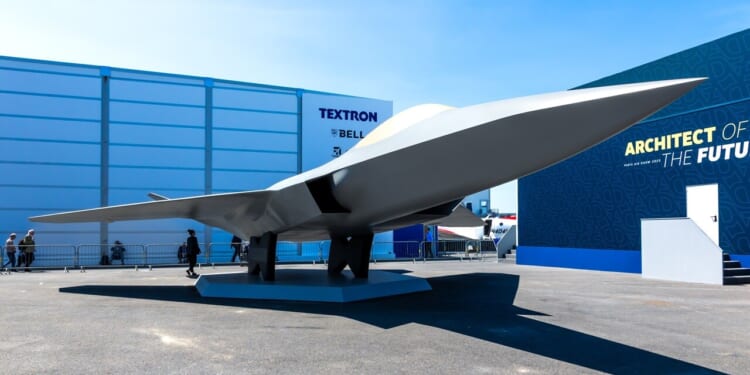The FCAS program’s struggles illustrate a simple fact: the Europeans are not sufficiently serious about their collective defense to put aside their differences and commit to working together.
Europe wants the world to believe it has—like flipping a light switch—gone from ignoring its national defense requirements for decades to donning armor and readying to make war against Russia. Amidst promises that they were going to drastically increase their defense spending, the European nations that belong to NATO point to ongoing projects such as the Future Combat Air System (FCAS) as proof-positive that they are dedicated to rearmament.
Much can be said of the FCAS program. It is, after all, a major European program aimed at developing a next-generation combat aviation ecosystem to replace fighters, like France’s legendary Rafale and the iconic (but aging) Eurofighter Typhoon used by Germany and Spain.
Launched back in 2017, this collaborative effort primarily involving France, Germany, and Spain—with the goal of achieving operational capability in distant 2040—has gained renewed interest in light of the Russian invasion of Ukraine and the advent of the competition for sixth-generation warplanes.
But the FCAS has hit several snags along the way that threaten to delay—and possibly torpedo—the program long before it takes off.
What to Know About the FCAS Program
The FCAS program is currently led by industrial partners including France’s Dassault Aviation, Germany’s Airbus, and Spain’s Indra. In 2023, Belgium joined as an observer in the FCAS project—becoming a full-fledged partner in the program by June of this year.
In December 2022, the FCAS program entered “Phase 1B,” which focuses on technology maturation and demonstrator development. This phase includes contracts for sensor suites and other components, with a push for signing Phase 2 later this year to enable flights of demonstrators by 2029. A first test flight of a fighter demonstrator, integrated with swarming drones and a “combat cloud,” is slated for either 2028 or 2029.
But the program, already a low-probability success, has been running into repeated problems. Significant delays and national tensions among the members have stymied progress. Thus far, much of the squabbling has been over things like workshare distribution, intellectual property (IP) rights, and leadership roles between the two European juggernauts, Dassault and Airbus.
In classic French fashion, Paris has repeatedly threatened to proceed independently if “no mutually acceptable” agreement is reached, with French government officials stating the country is capable of building the next-generation fighter alone. This is not an idle threat; France previously left the Eurofighter program over similar disputes in the 1980s, opting to develop the Dassault Rafale independently as the other partners created the Eurofighter Typhoon.
Germany, equally frustrated with its allies’ intransigence, has explored alternative partnerships, like joining Britain’s Global Combat Air Programme (GCAP) with Italy and Japan, or even collaborating with Sweden—though German and Swedish defense ministers have publicly denied any ongoing discussions on FCAS specifically.
Can the FCAS Program Be Saved?
A trilateral meeting hosted by Berlin next month is anticipated to address these issues. It is doubtful that they will be resolved, given that there are far too many hands on the steering wheel and way too many competing interests at play.
FCAS is designed to be a “system of systems” rather than a single aircraft, just as the American Next Generation Air Dominance (NGAD) program and China’s sixth-generation warplane project are designed to be. This means the FCAS, if it ever makes it off the drawing board, will integrate manned and unmanned platforms with advanced networking for multi-domain operations. FCAS will eventually enhance existing fleets before deployment.
Whatever the Europeans envisage for the FCAS program, there is a high probability that the different nations involved go their own way. One can foresee the Germans joining the Japanese and British on their project, the French choosing to develop a sixth-generation warplane capability on their own, and the Spanish abandoning the quest entirely—and possibly choosing instead to work with Turkey in developing the fifth-generation TAI KAAN warplane.
Regardless of the end result, the program’s struggles illustrate a simple central fact: the Europeans are not sufficiently serious about their collective defense to put aside their differences and commit to working together. Until they are, the FCAS is unlikely to move forward.
About the Author: Brandon J. Weichert
Brandon J. Weichert is a senior national security editor at The National Interest. Recently, Weichert became the host of The National Security Hour on America Outloud News and iHeartRadio, where he discusses national security policy every Wednesday at 8pm Eastern. He is also a contributor at Popular Mechanics and has consulted regularly with various government institutions and private organizations on geopolitical issues. Weichert’s writings have appeared in multiple publications, including The Washington Times, National Review, The American Spectator, MSN, The Asia Times, and others. His books include Winning Space: How America Remains a Superpower, Biohacked: China’s Race to Control Life, and The Shadow War: Iran’s Quest for Supremacy. His newest book, A Disaster of Our Own Making: How the West Lost Ukraine is available for purchase wherever books are sold. He can be followed via Twitter @WeTheBrandon.
Image: Shutterstock / VanderWolf Images.
















